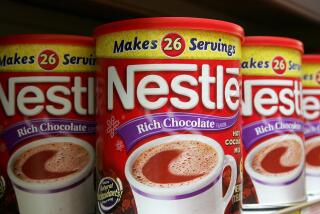Chocolate’s Not So Bad for You, After All
- Share via
We haven’t talked about chocolate for a while, except to comment occasionally that it is truly one of life’s great pleasures. Last Christmas, one of Santa’s best helpers brought us 4 pounds of the most wonderful chocolates ever made by a naked woman on a horse. So consequently, we have chocolate on the mind--and the fingers.
Chocolate and cocoa come from the seeds or beans of the cacao tree, technically known as Theobroma cacao. This most blessed of all trees is native to the tropics, so try as we might, most of us cannot grow it in our backyards.
“Nibs” are the heart of the beans, and they grow in foot-long pods that Mother Nature was determined to protect, so she encased them in an outer shell.
When cacao beans are processed, the nibs get finely ground into a “chocolate liquor,” which consists of cocoa solids and cocoa butter. The butter and the solids are separated and then recombined to form different varieties of chocolate.
In 1993, the U.S. Food and Drug Administration updated its standards for cacao products, and although the actual rules are far too technical to discuss, they are very specific. For instance, milk chocolate (probably the most popular type of chocolate) contains sugar, cocoa butter and milk, and there may be more of these three ingredients than chocolate itself. Semisweet chocolate, on the other hand, has a higher proportion of chocolate (a minimum 35% chocolate liquor is specified). Chocolate products will also contain emulsifiers (stabilizers) and flavorings.
*
Chocolate contains some caffeine but not very much. One ounce of bittersweet chocolate has about 20 to 30 milligrams; 1 ounce of milk chocolate has only 5 to 10 milligrams, and one 8-ounce cup of cocoa has about 6 milligrams (that’s one-fifteenth as much as a cup of instant coffee).
For the purposes of comparison, here is the calorie and fat composition of chocolate products per ounce:
* Bitter (dark) chocolate has 197 calories and 55 grams of fat.
* Bittersweet (semisweet) chocolate has 170 calories and 45 grams of fat.
* Sweet chocolate has 162 calories and 35 grams of fat.
* Milk chocolate has 150 calories and 30 grams of fat.
* Cocoa (powder) has 121 calories and 15 grams of fat.
And what about white chocolate? There is technically no such thing as actual white chocolate. Instead, there is a substance that contains only the fat (cocoa butter) but not the nonfat substances from the ground-up cacao nibs that give chocolate its color and flavor. In addition to cocoa butter, white chocolate also contains sugar, milk fats and milk solids. There is a misconception that because white chocolate is lighter in color, it is also lower in calories and fat as well. Wrong!
Chocolate has been the subject of a lot of general mythology, probably perpetrated by those killjoys who think anything that tastes so good must be bad. For example:
* Chocolate does not cause acne. Dermatologists have finally agreed that diet has nothing to do with acne.
* Chocolate does not raise blood cholesterol. Only milk chocolate has any cholesterol, and then only a very small amount. The fat in chocolate is saturated, but most of it is in the form of stearic acid, which does not seem to boost blood cholesterol the same way other saturated fats do.
* Chocolate is not addictive. Even though it may seem like you can’t live without chocolate sometimes--about 3:30 every afternoon around here--it is not an actual physical addiction the way nicotine is. Some research indicates that chocolate does produce a sensation not unlike that goofy feeling we often get by being in love.
* Chocolate does not cause tooth decay. Unless you eat chocolate in some very sticky form that stays trapped in your teeth, the cocoa actually seems to inhibit the bacterial growth that promotes plaque formation in the mouth.
* Chocolate does not interfere with calcium absorption. Chocolate does not bind up the calcium in chocolate milk. In fact, chocolate milk, flavored with low-fat cocoa, is a great way to get kids to drink milk.
Chocolate is high in calories, and it does add to the overall fat intake. But consumed in moderation, it can still be part of your healthy diet. One way to use chocolate in a low-fat diet is to substitute cocoa powder for chocolate whenever possible. This can save you as much as 10 grams of fat per ounce.
*
“The Wellness Lowfat Cookbook” (Rebus, 1993) has this recipe for Cocoa Fudge Cake with 180 calories and 4 grams of fat per serving.
COCOA FUDGE CAKE
1 1/2 cups unbleached all-purpose flour
1/2 cup unsweetened cocoa powder
1 teaspoon baking powder
1 teaspoon baking soda
2 tablespoons margarine
2/3 cup sugar
2 eggs
1 teaspoon vanilla extract
1 1/2 cups buttermilk
Preheat oven to 350 degrees. Spray an 8-inch round baking pan with nonstick cooking spray and dust it lightly with flour.
In a small bowl, stir together the flour, cocoa powder, baking powder and baking soda.
In a medium-size bowl, cream together the margarine and sugar. Beat in the eggs one at a time. Add the vanilla and half the buttermilk, then stir in half the dry ingredients. Add the remaining buttermilk and beat until blended, then beat in remaining dry ingredients.
Pour the batter into the pan and gently tap it to level the batter. Bake 35 to 40 minutes, or until a toothpick inserted in the center comes out clean and dry. Let cool 5 minutes and then run a knife around the edge to loosen it and turn it out.
Top with a nonfat whipped topping, fresh fruit, applesauce, frozen yogurt or whatever your heart desires. Makes about 10 servings.
More to Read
Eat your way across L.A.
Get our weekly Tasting Notes newsletter for reviews, news and more.
You may occasionally receive promotional content from the Los Angeles Times.










